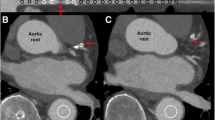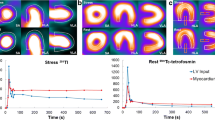Abstract
A novel single-photon emission computed tomography (SPECT) camera was developed to evaluate dynamic myocardial perfusion flow. However, it is unclear whether myocardial flow reserve (MFR) derived by dynamic perfusion SPECT using the novel SPECT camera (D-SPECT) reflects the severity of coronary atherosclerosis. In the present study, we therefore examined the relationship between MFR using D-SPECT and severity of coronary lesions. The study population comprised 40 patients who underwent both a myocardial dynamic perfusion SPECT study and invasive coronary angiography. The severity of coronary atherosclerosis was evaluated using the Gensini score. All patients underwent a rest/stress SPECT imaging protocol using Tc-99m-sestamibi, and dynamic acquisition was performed. Stress and rest flow was evaluated, and the global and regional MFR was calculated. Global MFR showed a significant negative correlation with Gensini score (r = − 0.345, p = 0.037). Multiple linear regression analysis showed that only global MFR was independently related to Gensini score (p = 0.018). Regional MFR was significantly lower in regions with 90% ≤ stenotic lesions compared with regions with < 90% stenotic lesions (p = 0.009). Global MFR derived by dynamic perfusion SPECT using D-SPECT reflects the severity of coronary atherosclerosis. Further, regional MFR is modulated by severe coronary artery stenotic lesions.





Similar content being viewed by others
Abbreviations
- CAD:
-
Coronary artery disease
- CFR:
-
Coronary flow reserve
- ICA:
-
Invasive coronary angiography
- LAD:
-
Left anterior descending
- LCX:
-
Left circumflex
- MFR:
-
Myocardial flow reserve
- MIBI:
-
Tc-99m-sestamibi
- PCI:
-
Percutaneous coronary intervention
- PET:
-
Positron emission tomography
- RCA:
-
Right coronary artery
- SDS:
-
Summed difference score
- SPECT:
-
Single-photon emission computed tomography
- SRS:
-
Summed rest sore
- SSS:
-
Summed stress score
References
Beller GA, Zaret BL (2000) Contributions of nuclear cardiology to diagnosis and prognosis of patients with coronary artery disease. Circulation 101(12):1465–1478
Hachamovitch R, Berman DS, Shaw LJ, Kiat H, Cohen I, Cabico JA et al (1998) Incremental prognostic value of myocardial perfusion single photon emission computed tomography for the prediction of cardiac death: differential stratification for risk of cardiac death and myocardial infarction. Circulation 97(6):535–543
Shaw LJ, Berman DS, Maron DJ, Mancini GB, Hayes SW, Hartigan PM et al (2008) Optimal medical therapy with or without percutaneous coronary intervention to reduce ischemic burden: results from the Clinical Outcomes Utilizing Revascularization and Aggressive Drug Evaluation (COURAGE) trial nuclear substudy. Circulation 117(10):1283–1291
Berman DS, Kang X, Slomka PJ, Gerlach J, de Yang L, Hayes SW et al (2007) Underestimation of extent of ischemia by gated SPECT myocardial perfusion imaging in patients with left main coronary artery disease. J Nucl Cardiol 14(4):521–528
Herzog BA, Husmann L, Valenta I, Gaemperli O, Siegrist PT, Tay FM et al (2009) Long-term prognostic value of 13N-ammonia myocardial perfusion positron emission tomography added value of coronary flow reserve. J Am Coll Cardiol 54(2):150–156
Hutchins GD, Schwaiger M, Rosenspire KC, Krivokapich J, Schelbert H, Kuhl DE (1990) Noninvasive quantification of regional blood flow in the human heart using N-13 ammonia and dynamic positron emission tomographic imaging. J Am Coll Cardiol 15(5):1032–1042
Gaibazzi N, Rigo F, Lorenzoni V, Molinaro S, Bartolomucci F, Reverberi C et al (2013) Comparative prediction of cardiac events by wall motion, wall motion plus coronary flow reserve, or myocardial perfusion analysis: a multicenter study of contrast stress echocardiography. JACC Cardiovasc Imaging 6(1):1–12
Nemes A, Forster T, Geleijnse ML, Soliman OI, Cate FJ, Csanady M (2008) Prognostic role of aortic atherosclerosis and coronary flow reserve in patients with suspected coronary artery disease. Int J Cardiol 131(1):45–50
Van Herck PL, Paelinck BP, Haine SE, Claeys MJ, Miljoen H, Bosmans JM et al (2013) Impaired coronary flow reserve after a recent myocardial infarction: correlation with infarct size and extent of microvascular obstruction. Int J Cardiol 167(2):351–356
Murthy VL, Naya M, Taqueti VR, Foster CR, Gaber M, Hainer J et al (2014) Effects of sex on coronary microvascular dysfunction and cardiac outcomes. Circulation 129(24):2518–2527
Park CS, Youn HJ, Kim JH, Cho EJ, Jung HO, Jeon HK et al (2006) Relation between peripheral vascular endothelial function and coronary flow reserve in patients with chest pain and normal coronary angiogram. Int J Cardiol 113(1):118–120
D’Andrea A, Caso P, Cuomo S, Scotto di Uccio F, Scarafile R, Salerno G et al (2007) Myocardial and vascular dysfunction in systemic sclerosis: the potential role of noninvasive assessment in asymptomatic patients. Int J Cardiol 121(3):298–301
Erlandsson K, Kacperski K, van Gramberg D, Hutton BF (2009) Performance evaluation of D-SPECT: a novel SPECT system for nuclear cardiology. Phys Med Biol 54(9):2635–2649
Gambhir SS, Berman DS, Ziffer J, Nagler M, Sandler M, Patton J et al (2009) A novel high-sensitivity rapid-acquisition single-photon cardiac imaging camera. J Nucl Med 50(4):635–643
Sharir T, Ben-Haim S, Merzon K, Prochorov V, Dickman D, Berman DS (2008) High-speed myocardial perfusion imaging initial clinical comparison with conventional dual detector anger camera imaging. JACC Cardiovasc Imaging 1(2):156–163
Ben-Haim S, Murthy VL, Breault C, Allie R, Sitek A, Roth N et al (2013) Quantification of myocardial perfusion reserve using dynamic SPECT imaging in humans: a feasibility study. J Nucl Med 54(6):873–879
Shiraishi S, Sakamoto F, Tsuda N, Yoshida M, Tomiguchi S, Utsunomiya D et al (2015) Prediction of left main or 3-vessel disease using myocardial perfusion reserve on dynamic thallium-201 single-photon emission computed tomography with a semiconductor gamma camera. Circulation 79(3):623–631
Slomka PJ, Alexanderson E, Jacome R, Jimenez M, Romero E, Meave A et al (2012) Comparison of clinical tools for measurements of regional stress and rest myocardial blood flow assessed with 13N-ammonia PET/CT. J Nucl Med 53(2):171–181
Cerqueira MD, Weissman NJ, Dilsizian V, Jacobs AK, Kaul S, Laskey WK et al (2002) Standardized myocardial segmentation and nomenclature for tomographic imaging of the heart: a statement for healthcare professionals from the Cardiac Imaging Committee of the Council on Clinical Cardiology of the American Heart Association. Circulation 105(4):539–542
Gensini GG (1983) A more meaningful scoring system for determining the severity of coronary heart disease. Am J Cardiol 51(3):606
Johnson NP, Gould KL (2012) Integrating noninvasive absolute flow, coronary flow reserve, and ischemic thresholds into a comprehensive map of physiological severity. JACC Cardiovasc Imaging 5(4):430–440
Austen WG, Edwards JE, Frye RL, Gensini GG, Gott VL, Griffith LS et al (1975) A reporting system on patients evaluated for coronary artery disease. Report of the Ad Hoc Committee for Grading of Coronary Artery Disease, Council on Cardiovascular Surgery, American Heart Association. Circulation 51(4 Suppl):5–40
Uren NG, Melin JA, De Bruyne B, Wijns W, Baudhuin T, Camici PG (1994) Relation between myocardial blood flow and the severity of coronary-artery stenosis. N Engl J Med 330(25):1782–1788
Di Carli M, Czernin J, Hoh CK, Gerbaudo VH, Brunken RC, Huang SC et al (1995) Relation among stenosis severity, myocardial blood flow, and flow reserve in patients with coronary artery disease. Circulation 91(7):1944–1951
Naya M, Tamaki N, Tsutsui H (2015) Coronary flow reserve estimated by positron emission tomography to diagnose significant coronary artery disease and predict cardiac events. Circulation 79(1):15–23
Taqueti VR, Everett BM, Murthy VL, Gaber M, Foster CR, Hainer J et al (2015) Interaction of impaired coronary flow reserve and cardiomyocyte injury on adverse cardiovascular outcomes in patients without overt coronary artery disease. Circulation 131(6):528–535
De Bruyne B, Fearon WF, Pijls NH, Barbato E, Tonino P, Piroth Z et al (2014) Fractional flow reserve-guided PCI for stable coronary artery disease. N Engl J Med 371(13):1208–1217
Pijls NH (2013) Fractional flow reserve to guide coronary revascularization. Circulation 77(3):561–569
Echavarria-Pinto M, Escaned J, Macias E, Medina M, Gonzalo N, Petraco R et al (2013) Disturbed coronary hemodynamics in vessels with intermediate stenoses evaluated with fractional flow reserve: a combined analysis of epicardial and microcirculatory involvement in ischemic heart disease. Circulation 128(24):2557–2566
Klocke FJ (1987) Measurements of coronary flow reserve: defining pathophysiology versus making decisions about patient care. Circulation 76(6):1183–1189
Acknowledgements
This study was supported by the Sakakibara Clinical Research Grant for Promotion of Science. We thank Spectrum Dynamics for providing technical support, Makiko Kurihara for technical assistance, Dr. Shlomo Ben Heim for assistance, and Edanz Group (http://www.edanzediting.com/ac) for editing a draft of this manuscript.
Author information
Authors and Affiliations
Contributions
NI, YU, YS: directly participated in the planning, execution, or analysis of the study. MS, KH, RH, IT, TT: contributed to data collection. TS: supervised the study. MI: contributed to the editing of the manuscript. All authors read and approved the final manuscript.
Corresponding author
Ethics declarations
Conflict of interest
Nobuo Iguchi and Yuko Utanohara have received honorariums from Biosensors Japan. Yasuhiro Suzuki is a consultant of Biosensors Japan. The other authors declare no conflicts of interest regarding the publication of this paper.
Ethical approval
All procedures performed in studies involving human participants were in accordance with the ethical standards of the institutional and/or national research committee and with the 1964 Helsinki declaration and its later amendments or comparable ethical standards. The study protocol was approved by the in-house ethics committee of the Sakakibara Heart Institute.
Rights and permissions
About this article
Cite this article
Iguchi, N., Utanohara, Y., Suzuki, Y. et al. Myocardial flow reserve derived by dynamic perfusion single-photon emission computed tomography reflects the severity of coronary atherosclerosis. Int J Cardiovasc Imaging 34, 1493–1501 (2018). https://doi.org/10.1007/s10554-018-1358-5
Received:
Accepted:
Published:
Issue Date:
DOI: https://doi.org/10.1007/s10554-018-1358-5




